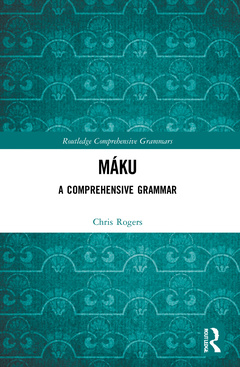Máku A Comprehensive Grammar Routledge Comprehensive Grammars Series
Auteur : Rogers Chris

Máku: A Comprehensive Grammar is a comprehensive reference grammar of the Maku language, spoken by the jukudeitse who once lived in Venezuela and Brazil. Based on fieldwork with the final two speakers of the language, it describes all core aspects of the grammatical system as they have been recorded; presented through lexical items, example sentences and texts.
This book offers a description of the now-extinct language. It was written in response to the loss of linguistic information generally and the significance this language has for the study of the sociolinguistic history of the region specifically. This information contributes to our understanding of linguistic diversity and the indigenous linguistic ecologies in the Americas. Also included is data about language contact via loanwords with other indigenous language spoken in the Northern Amazonian region. The resources in this book are essential for language comparisons and language histories in Venezuela and Brazil.
Máku: A Comprehensive Grammar is an important reference for researchers and students in the fields of linguistics, anthropology, sociology, history and the study of Amazonian languages.
Contents
List of Figures
List of Tables
Preface
Acknowledgements
Abbreviations and Symbols
CHAPTER 1 INTRODUCTION
1.1 THE SOCIAL AND CULTURAL CONTEXTS OF MÁKU
1.1.1 The use of Máku in the Wider Pre- and Post-contact Context
1.1.2 Language contact
1.2 DATA SOURCES AND THE MÁKU DATABASE
1.2.1 Sinfrônio’s idiolect
1.3 ORGANIZATION OF THE GRAMMAR
CHAPTER 2 PHONOLOGY
2.1 CONSONANTS
2.1.1 Phonological alternations affecting consonants
2.1.2 Consonant distribution
2.2 VOWELS
2.2.1 Phonological alternations affecting vowels
2.2.2 Vowel distribution
2.3 SYLLABLE STRUCTURE
2.4 STRESS ASSIGNMENT
CHAPTER 3 MORPHOLOGY PART I: WORD CLASSES AND INFLECTIONAL MORPHOLOGY
3.1 NOUNS
3.1.1 Number
3.1.2 Case
3.1.3 Possession
3.2 PRONOUNS
3.2.1 Personal pronouns
3.2.2 Demonstrative pronouns
3.2.3 Interrogative pronouns
3.2.4 Indefinite pronouns
3.3 QUANTIFIERS
3.3.1 Numbers
3.3.2 Indefinite quantifiers
3.4 POSTPOSITIONS
3.5 VERBS
3.5.1 Agreement
3.5.2 Tense-aspect-mood-evidentiality
3.5.3 Suppletion
3.6 ADVERBS
3.7 CONJUNCTIONS, INTERJECTIONS, IDEOPHONES, AND LEXICALIZATION
CHAPTER 4 MORPHOLOGY PART II: DERIVATIONAL MORPHOLOGY AND COMPOUNDS
4.1 DERIVATIONAL MORPHEMES
4.1.1 Diminutive -taka
4.1.2 Approximative -dakaja
4.1.3 Limitation suffix -mu
4.1.4 Verbal noun -na
4.1.5 Desiderative/negative desiderative suffixes
4.1.6 Bereavement
4.1.7 Circular-motion suffix -liku and circumventing-motion suffix -dakana
4.1.8 Valency-adjusting ku-
4.1.9 Reduplication
4.1.10 -ema
4.1.11 Allative -le
4.2 STEM COMPOUNDS
4.2.1 Idiomatic noun phrases
4.3 FLUIDITY OF GRAMMATICAL CATEGORIES
CHAPTER 5 SYNTAX
5.1 CONSTITUENT PHRASES AND DECLARATIVE CLAUSES
5.1.1 Phrases
5.1.2 Declarative clause types
5.2 IMPERATIVE CLAUSES
5.3 INTERROGATIVE CLAUSES
5.3.1 Constituent questions
5.3.2 Polarity questions
5.4 COMPLEX SENTENCES
5.4.1 Coordination
5.4.2 Subordination
5.5 INFORMATION STRUCTURE
5.5.1 Ellipsis
5.5.2 Focus positions and the clitic =ke
5.5.3 Particles etsiwa and ijani
CHAPTER 6 TYPOLOGICAL SIMILARITIES
CHAPTER 7 TEXTS
7.1 THE OPOSSUM AND THE TURTLE
7.2 BUCHA AND MAKUNAIMA
7.3 MENIWA
7.4 FLOOD
7.5 MALOAKA
CHAPTER 8 GLOSSARIES
8.1 MÁKU-ENGLISH-PORTUGUESE GLOSSARY
8.2 ENGLISH-MÁKU WORD LIST
REFERENCES
INDEX
Chris Rogers is an Assistant Professor of Linguistics at Brigham Young University, USA. Motivated by a passion for linguistic fieldwork, he has conducted original research on the Xinkan (Guatemala), Inapari (Peru), Mixteco (Mexico), Wichi’ (Argentina), Quechua (Peru), Ninam (Brazil) and Maku (Venezuela) languages.
Date de parution : 08-2022
15.6x23.4 cm
Date de parution : 12-2020
15.6x23.4 cm
Thèmes de Máku :
Mots-clés :
Nasal Place Assimilation; Voiced Alveolar Stop; Northern Amazonian region; Past Tenses; Grammatical system; Intransitive Stative Verb; Maku language; Intransitive; Sociolinguistic history; Intransitive Verbs; Amazonian languages; Rice 1928a; Serial Verb Constructions; Intervocalic Voicing; South American Languages; Amazon Basin Region; Noun Phrase; Vowel Space; Van Gijn; Simulative Marker; Unrounded High Front Vowel; Postpositional Phrase; Pulmonic Egressive Airstream; Vowel Segments; High Front Vowel; Language Attrition; Declarative Clauses; Transitive Active Verbs; Vowel Inventory



